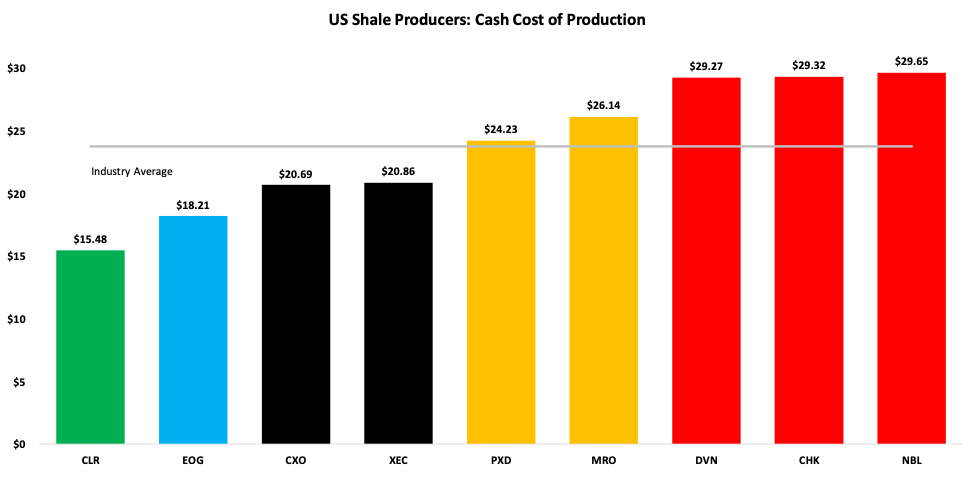Advisor Perspectives welcomes guest contributions. The views presented here do not necessarily represent those of Advisor Perspectives.
Q1 hedge fund letters, conference, scoops etc

"When a company is selling a product with commodity-like economic characteristics, being the low-cost producer is all-important."
Warren Buffett, Berkshire Hathaway shareholders letter, 2000, emphasis ours
“In many industries (reference to commodities), differentiation simply can’t be made meaningful. A few producers in such industries may consistently do well if they have a cost advantage that is both wide and sustainable. By definition such exceptions are few, and, in many industries, are non-existent. For the great majority of companies selling “commodity” products, a depressing equation of business economics prevails: persistent over-capacity without administered prices (or costs) equals poor profitability.” - Warren Buffett, Berkshire Hathaway shareholders letter, 1982, emphasis ours
This is the eights article in our series of articles discussing our analytical framework for identifying and assessing the existence and persistence of competitive advantages. In this article, we discuss a very limited form of moat – one driven by low cost advantage that is not a result of scale of operations.
Defining low-cost producer (LCP) moats
LCP moats exist when the business is one of, if not the, lowest cost producers in its industry. Importantly, the cost advantage should not be a result of economies of scale (EoS). Instead, the advantage that we are interested in here is a result of advantaged source of production or advantaged access to raw materials used in production. This is especially the case with natural resource producers or companies that use natural resources as their raw materials.
LCP moats are not the same as economies of scale
Frequently, analysts classify such moats as economies of scale because of the basic characteristic of both these moats; low costs in relation to competitors. However, LCP-based moats are a specific case of competitive advantage where the cost of production isn’t just a factor of the scale of production or the type of production technology employed. These in turn are the primary determining factors for economies of scale (EOS) moats as the per-unit fixed cost declines as output increases and the per-unit variable cost reduction is a factor of operational efficiencies and synergies.
LCP moats – differentiating characteristics
The distinguished source of advantage for LCP moats as compared to EoS moats gives birth to two important differentiating factors. Firstly, as the cost advantage of LCP moats is not a factor of scale, they are harder and frequently impossible to replicate. On the other hand, a motivated entrant with access to capital always has the possibility of replicating the EoS advantages.
In this respect, LCP-based moats have a wider advantage as compared to that of EoS-based moats. Secondly, much as it is difficult for a new entrant to replicate the advantaged capacity of the incumbent, for the incumbent it is hard to translate their cost advantages to their new capacities, especially so for greenfield capacities. This factor limits the business-value growth possibilities for such moats. The limited ability to grow business values is the primary reason why we classify such moats as the weakest source of competitive advantages.
Analytical framework: LCPs and sustainable competitive advantages
For low cost of production to lead to sustainable competitive advantages, two critical elements need to be present, namely wide distribution of industry’s cost curve and limited availability of low-cost sources of supply.
- Wide distribution of Industry’s cost curve
The most important element that dictates the extent of competitive advantage of LCP-based moats is the variance in costs of production of the industry. The wider the distribution of production costs across available capacities within the industry, the wider the competitive advantage for low cost producers.
- Limited availability of low-cost sources of supply
The second factor that determines the extent as well as the durability of the competitive advantage of LCP-based moats is the availability of supply at advantaged costs as a proportion of the industry’s total supply curve. In general, less than half of the overall supply curve should be covered by low-cost sources of supply.
The analyst should pay special attention to the current demand for the industry’s products in relation to full-cycle demand levels. Preferably, the amount of supply provided by low-cost suppliers will be less than the worst-case demand scenario for the industry’s products.
Consider the case of EOG Resources. EOG is the third-largest oil producer in the U.S. and is the leader in extracting oil from tight shale formations. It is amongst the lowest-cost shale oil producer in the U.S. upstream segment driven by its highly productive premium acreage in a number of shale plays (primarily Eagle Ford and Permian). EOG’s premium drilling locations produce twice as much gross oil as the non-premium locations and operate at much lower finding and development costs.
The only other player with a lower cost of production is Continental Resources. Continental’s cost leadership emanates from its ownership of low-cost oil-rich assets in the Bakken field where it is a top operator.
Figure 1 shows our estimate of cash cost of production for U.S. shale oil producers. As is seen, EOG and Continental are the lowest cost producers with a reasonably wide distribution of industry cots curve that spans from $15 to $30 per barrel.
Figure 1. Cash cost of production for U.S. shale oil producers
Source: Company data and MAEG calculations1
Read the full article here by Baijnath Ramraika, Prashant K. Trivedi, Siddhi Gujar - Advisor Perspectives


